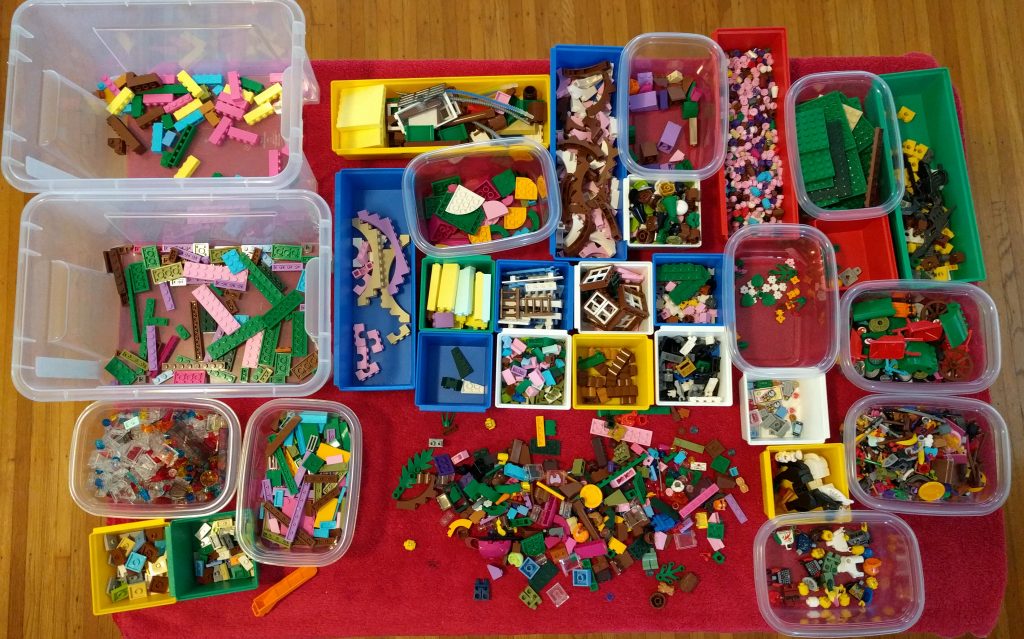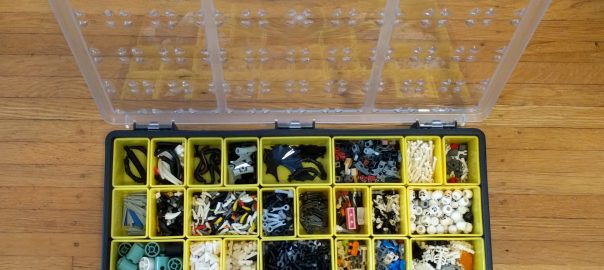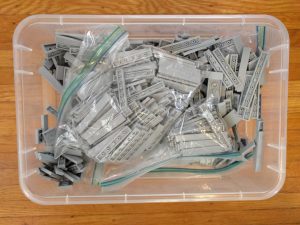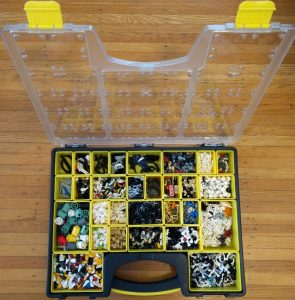I’m finally getting around to some long-overdue sorting.

For me, sorting is a several stage process. The first stage is a general sort, as you see here, where the parts are split up into several major categories. The general process is to dump out some parts on a towel with a bunch of containers surrounding, and put the parts into those containers by type.
In some cases, these containers correspond directly to one of the storage bins they will end up in, so that as each of these containers fills up it can be just dumped into that bin. But there are far more storage bins than can reasonably fit on this table, so secondary stages of sorting are needed for most cases. Each time I do the sort the top-level categories are a bit different, but this is a fairly typical example.
In this case, the top level categories (roughly counter-clockwise from top left) are:
- Basic bricks – any plain ordinary 1xN or 2xN bricks. These will be later sorted by color, and then by size.
- Basic plates – 1xN, 2xN, and 3×3 plates go here, and similar to bricks are later sorted by color then size.
- Transparent parts – anything transparent goes here. Later they will be sorted by size/shape. Printed transparent spaceship/aircraft canopies go here, but smaller printed transparent parts go in the printed category (see below).
- 2×2 jumper tiles & 1×2 jumper tiles – these will just be dumped into the bin for each size.
- Tiles – smooth tiles, as well as some parts that I classify as ‘modified tiles’ such as grilles, plates with limited studs, etc. These are later sorted by color and then size for the plain tiles, like the bricks and plates, while the modified tiles go in a separate bin and are sorted by size/shape. (While jumper plates would qualify as modified tiles, they are so common they get their own storage bins.)
- Full arches – there is a bin for these, sorted by size. Half arches are stored separately (see below).
- Wedge plates & bricks – I have a bin for the plates and another for the bricks, and within those they are sorted by size/shape.
- Tall bricks – any brick taller than the normal brick size. These will then be sorted by size and stored accordingly.
- Curved parts – curved slopes, rounded plates and bricks, etc. that have diameter greater than 2 studs. These will require further sorting by size/shape.
- Fences – these are stored in a bin without further sorting.
- Cheese slopes & short panels – will undergo further sorting by size/shape.
- Modified bricks – log/profile/grooved bricks, bricks with clips, etc. are stored together in a bin, sorted by size/shape.
- Windows – there is a bin of windows with bags for each type of window.
- SNOT (Studs Not On Top) parts – all the bricks or plates with studs on the side, brackets, etc. will be further sorted by size/shape in a second pass.
- Modified plates – plates with clips or bars or similar, will be stored by size/shape
- Plants – flowers, plants, etc. are stored in a bin with bags for each type.
- Printed parts – anything with printing or a sticker goes into the printed bin, with further sorting by type (food items, computers, etc.)
- Animals – horses and their tack, Friends animals, bugs, etc. have a bin with bags for a few sub-categories.
- Minifigures – All the body parts and clothing items are stored in a bin organized by type
- Minifigure accessories and misc small parts – these will undergo further sorting and be stored by type.
- Vehicle parts – cars, trains, planes, and boats as well as wheeled minifigure accessories such as bikes and wheelbarrows. Further sorting by type will be done later.
- Technic parts – basically anything with a pin/axle connection, except for things like the 2×2 rounds
- Big plates – anything 4x or greater is organized by size
- 1×1 round things – will be sorted by shape and stored
- 2×2 round things – same as above
- Slopes – anything with a non-vertical diagonal straight edge. Secondary sort by the angle of the slope, and then by color.
- Half arches – I split these out from the full arches just because the full arch container got filled up
- Rounded parts – any plates or bricks with a rounded edge, and curved slopes. These are then sorted by size/shape for storage.
- Miscellaneous – the remaining parts, mostly larger and less common parts, go here, and will be sorted further by type.
In most cases my storage system involves bins full of bags – the two bins on the top left of the image are the smallest size in my storage system. The bins are IKEA “Samla” storage bins, which come in several sizes, and then in each bin I have several zipper lock plastic bags. In the above image you can also see the sorting bins that I have been using for many years. I don’t think that they are available any longer in these bright colors, but I did find the Dial Industries White 10 Piece Drawer Organizer Set on Amazon which appears to be the same containers but in all white. I’ve also got a number of generic disposable food storage containers that I got at a discount grocery store, which hold about the same as the long skinny drawer organizer containers.
When storing sorted parts into the Samla bins, I often just dump all the parts for a bin into that bin alongside the more specific bags, and then I can often defer the final sorting until a later date. For example the bricks and plates and tiles are organized into bins by color (or in less common colors, large zipper lock bags of that color) with smaller bags inside for each size/shape. When building something, I can often find the parts I need just floating around in the bin, until that gets annoying and I do some more sorting. For example, here’s the bin of light grey tiles:
In addition to these, I also have some Stanley Professional Organizer storage boxes (10 bin and 25-bin versions) which I use to store smaller parts, such as the small transparent plates and tiles, the minifigure accessories, SNOT parts, etc. For example, here’s the one I called “critter parts” which contains parts for creating animals, monsters, and robots:
How do you do your sorting?




I do some similar stuff. My first pass sorting varies from time to time, and is not quite the same as yours. My first pass sorting attempts to sort things that will go to a similar place in my storage system into the same bin, so when I do a 2nd pass sort (or even 3rd pass sort), and finally putting things away, I won’t be going into every bin. First pass sort sometimes sorts pieces of high interest into a final sort.
I like your idea of dumping partially sorted things into a big bin with the final sort in baggies. Some reasons that won’t work for me are:
Overly stuffed bins, such that it would be a pain to get the loose parts, and many would come out with the baggies.
Bins that have a very common piece loose in the bottom of the bin (for example Green 2×4, 1×2, and 2×2 are each loose in the bottom of one of the three bins of green brick and plate). In those cases, the loose pieces are in such quantity that bagging them would make for an inefficient fit into the bin.
I’d love those Stanley organizers, but I was already heavily invested in Plano boxes by the time they appeared (or at least were pointed out), now it would eat up too much of my LEGO budget to convert).
Either a bin is all full of the same kind of part (e.g. jumper plates of all colors, no bags) or it is all full of bags with some unsorted elemnts sometimes mixed in (like the grey tiles example). In that example, the tiles are filling that bin all the way up, so if I want to build with grey tiles I’ll have to either pick out the loose ones, or dump them into a bowl first – that will likely prompt me to sort the loose ones into their bags soon.
Overly stuffed bins are not a problem as long as the bags are not overly stuffed. If you have a less-than-half-full gallon bag instead of a bulging quart bag, the bag can easily accommodate whatever open space is needed. Upgrade to a larger bag sooner rather than just waiting until it is all full, and then it’s no problem to cram a lot into a bin. When a bin is really stuffed, it’s time to move that part to a larger bin, or put some of the parts in archival storage.
Good points about size of bags and fullness of bins. My very full bins are often rarer colors which I don’t want to put any in archival storage (I do have plenty of stuff out in the garage). I have maxed out the space for bins in my LEGO room (plus I can no longer get the Iris drawers that I use…), so that has led to some of the other over stuffed bins.
Really I need to build more so those over stuffed bins will become not over stuffed…
yup – if you have a bin that’s too full, challenge yourself to build something using whatever parts are in it!